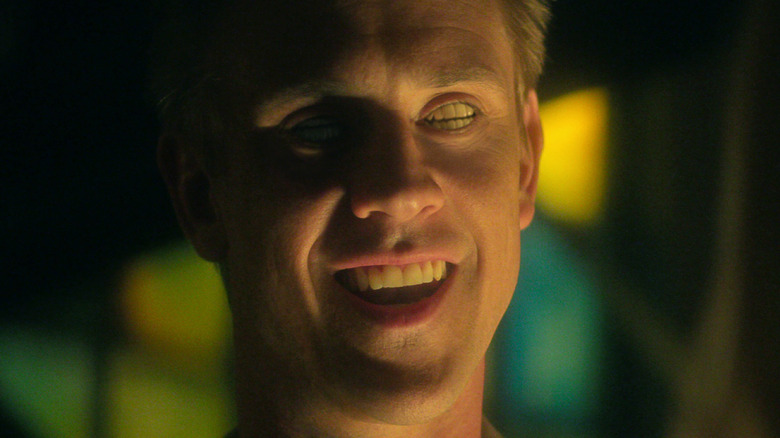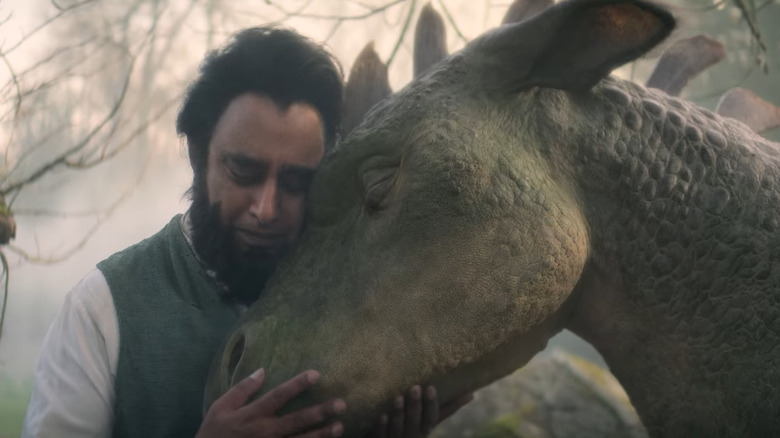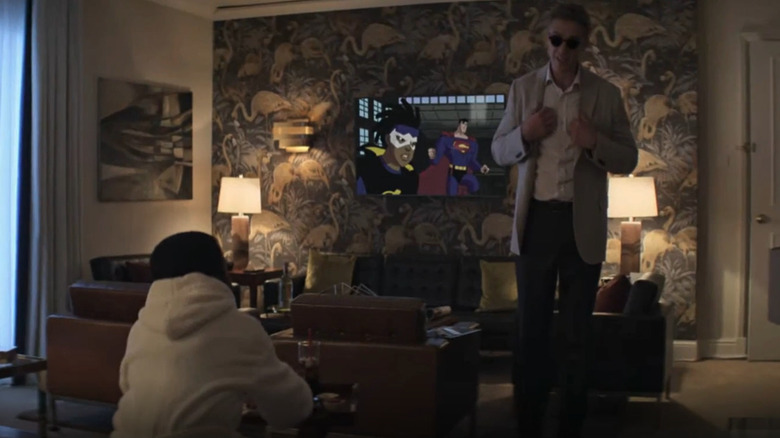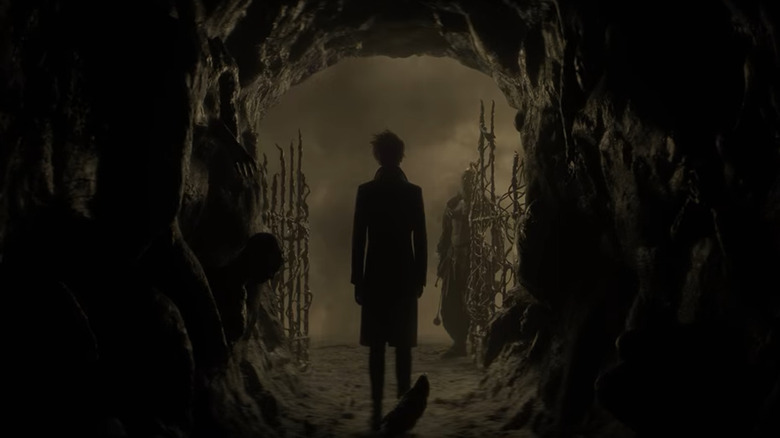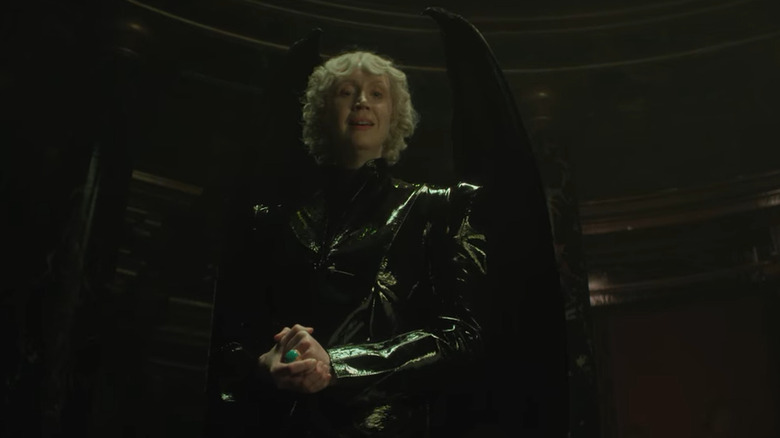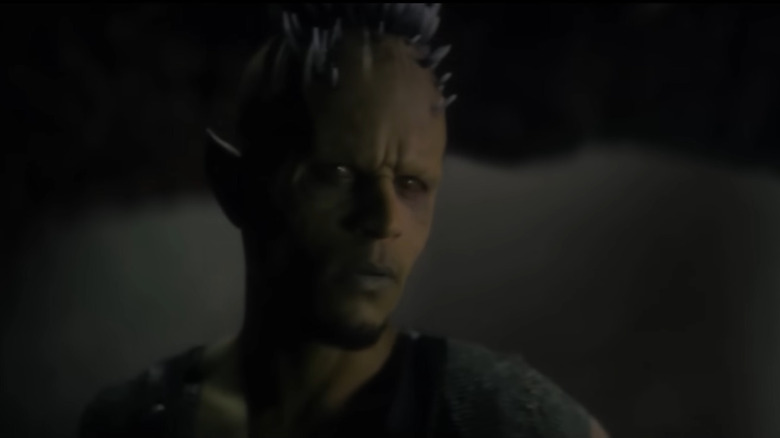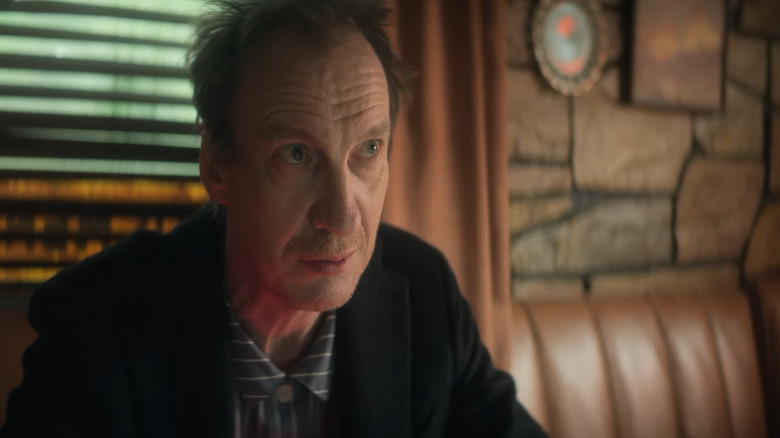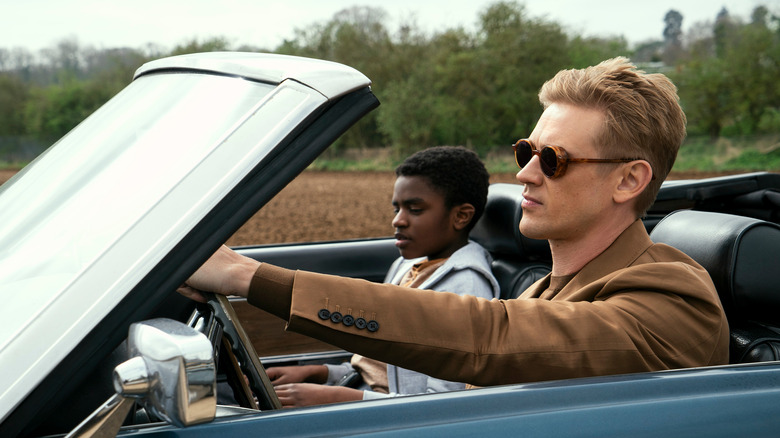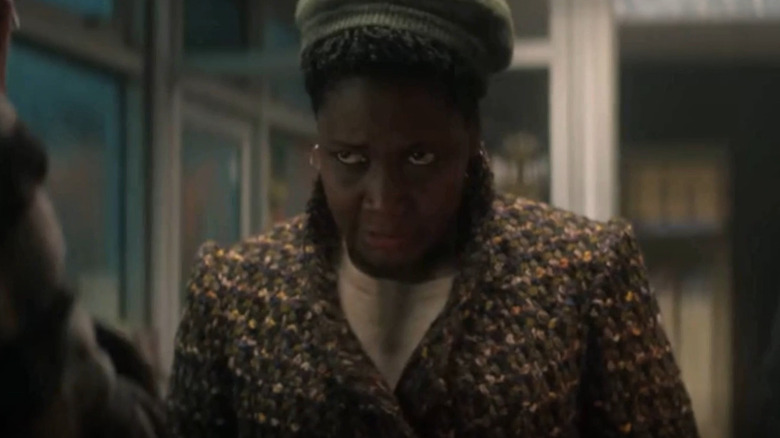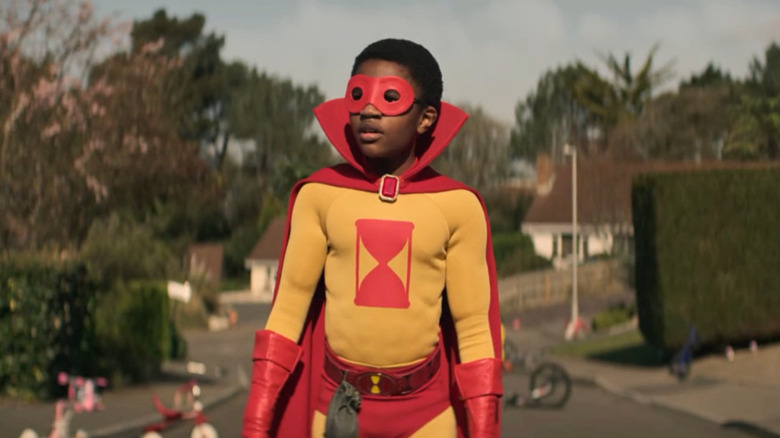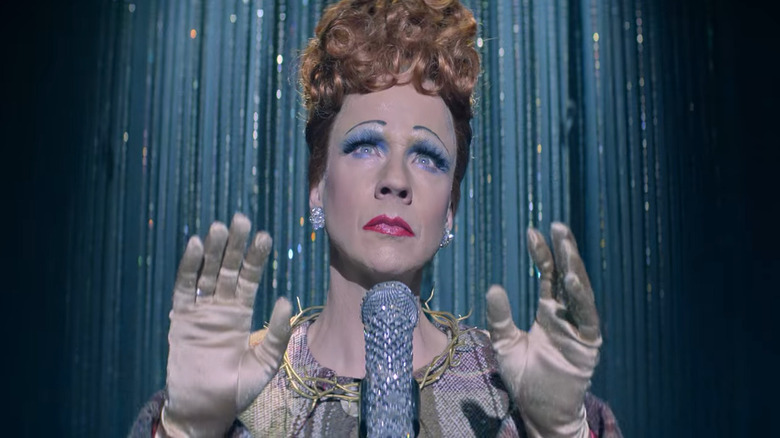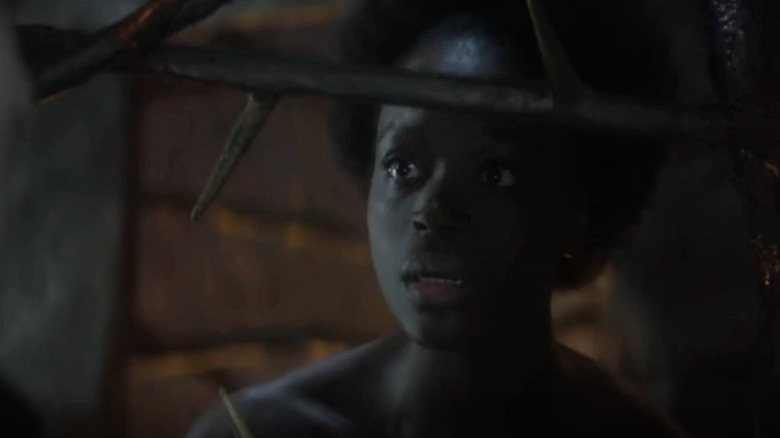The Sandman Season 1 Moments That Upset Fans The Most
Based on the 1989 DC comic "Sandman," Netflix's new show is a surprisingly faithful adaptation. Every episode directly relates to either a story or a combination of stories from the comics series' initial 16 issues, covering the first two collected volumes — "Preludes & Nocturnes" and "The Doll's House."
Fans loved seeing iconic characters like Morpheus (Tom Sturridge), Mervyn Pumpkinhead (Mark Hamill), and the Corinthian (Boyd Holbrook) brought to life in pin-perfect detail in the show's amazing 10-episode first season. Many were thrilled to rediscover the potent stories of reluctant dream vortex Rose Walker (Vanesu Samunyai), the immortal Hob Gadling (Ferdinand Kingsley), and the dastardly John Dee (David Thewlis). But that doesn't mean there aren't a few changes that some might have found to be a step away from the source material.
Though the live-action adventures of the Lord of Dreams managed to meet many people's expectations, here are some moments from the first season of "The Sandman" that could make some fans cranky.
What follows contains spoilers for "The Sandman" Season 1.
Saying goodbye to Gregory
In "Imperfect Hosts," the second episode of "The Sandman," Morpheus returns to his realm of the Dreaming and seeks out a means of regaining his power after being imprisoned for more than a century. In the comics issue of the same name, Dream accomplishes this by taking his power from letters he wrote for the brothers Cain (Sanjeev Bhaskar) and Abel (Asim Chaudhry). In the television adaptation, he finds a far more brutal solution by destroying the brothers' gargoyle companion Gregory.
While this change definitely ups the stakes for the show on a dramatic and emotional level, fans of the character might not appreciate Gregory's appearances being cut incredibly short. For those unfamiliar with the comics, the emotional impact might be even further dampened by the show not spending much time establishing the character in the first place.
Though this moment is a slightly questionable choice, it does help give Dream a more unpredictable edge. This also leads to another positive change. The comics issue includes Cain gifting his brother a baby gargoyle named Goldie. The series shifts Goldie to a gift from Morpheus as a means of apology, further developing his character's ambiguity.
Constantine confusion
In the third issue of the "Sandman" comic, "Dream a Little Dream of Me," Dream teams up with "Hellblazer" star John Constantine in order to retrieve his stolen pouch of sand. For the Netflix series, the comics character once portrayed by both Keanu Reeves and Matt Ryan has been changed to Johanna Constantine, portrayed by onetime "Doctor Who" companion Jenna Coleman.
Though some assumed the change was due to J.J. Abrams tying up the rights to the character, "Sandman" creator Neil Gaiman clarified in an interview with /Film that the change was made early on in the process to increase the screentime for the actress who would also be playing Constantine's ancestor in a later episode, a character that Gaiman himself created.
While Jenna Coleman does an amazing job as both characters, this does lead to some potential confusion when the Constantine ancestor shows up in the sixth episode, "The Sound of Her Wings." The ancestor, also named Johanna Constantine, confronts Morpheus and an immortal man named Hob Gadling. Considering they're looking at the same actress playing a character with the same name during a confrontation about immortality, casual viewers might think that both Constantines are one and the same character. This confusion could have easily been sidestepped by either giving one of the Constantines a different name or a different actress.
We don't need another hero
Though there are a few Easter eggs hinting at the DC Comics origin of "The Sandman," most of the more blatant connections to the world of superheroes have been removed. Most of this can probably be chalked up to rights issues or wanting to ground the Netflix series in a more realistic world, much like the comic itself does after its first arc. However, it can't be denied that part of the fun of the early run of the comics was seeing Morpheus interact with Martian Manhunter and Scott Free during his quest to track down his stolen items and visiting Arkham Asylum to return a defeated foe.
The character of Dream was even initially conceived by creator Neil Gaiman as a return of the 1970s comics character created by Joe Simon and Jack Kirby before being asked to make this Sandman a separate character. In the first issue of the series, there's even a small scene featuring the original 1930s Sandman who was one of the founders of the Justice Society of America.
While removing Dream from the world of comic book superheroes might have ultimately been the right choice for the show, it would have been delightfully weird to see the two worlds collide.
Squatterbloat takes Etrigan's place
When Morpheus goes to Hell to seek his stolen helm in "The Sandman" Episode 4, titled "A Hope in Hell," the Lord of Dreams is greeted at the gates by a rhyming demon named Squatterbloat (Martyn Ford).
While this character does appear in the comics issue of the same name, his physical appearance is far more memorable. The television version of Squatterbloat is brought to life by a 6-foot-8-inch, 320-pound bodybuilder menacingly towering over Dream. However, the comics character is a hunched over beast with animal-like feet and a large ax in place of where one of his hands should be, barely half the height of Lord Morpheus.
In the comics, Squatterbloat is relieved of his duty by a yellow demon cloaked in red named Etrigan who leads Morpheus to the ruler of Hell, Lucifer. However, the television series omits Etrigan entirely. Whether this was to move the story along or to avoid using characters from the larger DC Universe is uncertain, but fans hoping to see the Jack Kirby creation come to life will be greatly disappointed by Etrigan's absence.
David Bowie isn't Lucifer
While multiple characters in Netflix's "The Sandman" are reimagined as a different gender or with a different skin color than their original incarnations, when it came to Lucifer, fans griped about Gwendoline Christie's costume as much, if not much more, than her lack of male anatomy.
Lucifer's appearance in the comics is largely based on music legend David Bowie. A user on Twitter noted that casting Christie as the leader of Hell was a big change. While it's technically accurate to say that Christie is certainly not Bowie, "Sandman" creator Neil Gaiman explained the reason why they couldn't cast the "Life on Mars?" songster in a retweet stating, "Dude. This is going to hurt, but David Bowie's dead. We knew he wasn't available to play Lucifer any longer. That's why we cast Gwendoline Christie."
While some of the characters have been changed from their original comic conceptions on a surface level, they largely embody the essence of the character they portray. Perhaps the Thin White Duke would've made a stellar Lucifer, but he's not in a position to embody any kind of essence on television at the moment.
The battle of wills
In the fourth episode of "The Sandman," Dream finds that the helm stolen from him is in possession of a demon named Choronzon (Munya Chawawa). However, Choronzon does not wish to return the helm to Dream and challenges him to a battle of wills.
Up to this point, the scene appears to be lifted straight from the comics issue "A Hope in Hell." Where it differs is when Choronzon asks Lucifer to be his champion. Lucifer accepts and begins an intense metaphysical battle with the Lord of Dreams.
The battle itself follows the comics version closely, with the only difference being one of the combatants. While having Lucifer compete directly against our hero results in a more dramatic standoff between two powerful figures, there are some who might be dismayed that Choronzon, the demon who directly defies Morpheus, does not personally get defeated and humiliated for his unearned bravado.
John Dee's doctorate in destiny
The man who possesses Dream's powerful ruby is escaped mental hospital patient John Dee (David Thewlis). Using the ruby to make dreams come true, Dee personally terrorizes a 24-hour diner while affecting the entire world around him.
The television version of this character hints at a dangerous past with the ruby that led him to making deadly decisions, but the comics iteration is much clearer about his history as the supervillain Doctor Destiny. In addition to the ruby alerting his mind, it also left him in a physically debilitated state after the Justice League removed the ruby from his possession.
The show tones down John Dee's deformed physical appearance. In addition, the comics character spends most of his time wearing nothing more than a large overcoat. While the coat made its way into the television adaptation, Netflix's John Dee also scored some pajamas to wear underneath. While Thewlis manages to properly convey the uneasy menace of John Dee, some viewers might miss his supervillain origins and horrifying visage.
The Corinthian spins his wheels
While only introduced in "Sandman" comics in the 10th issue, "The Doll's House," the Corinthian (Boyd Holbrook) shows up comparatively early in the very first episode of the television series. The mouth-eyed nightmare continues to appear throughout the story, substantially beefing up his character's significance.
Holbrook is absolutely captivating as the charismatic monster that inspires hordes of serial killers and his manipulation of those connected to Morpheus is definitely intriguing. However, by placing the character where he previously did not appear, he is sometimes relegated to either providing exposition or spinning his wheels to remind the audience he's there until he can finally get a scene where he actually does something interesting.
Though the Corinthian is wonderfully acted and some of these new changes add surprising depth, fans might be annoyed at the occasional deflation of the character by putting him where he doesn't necessarily need to be.
The fate of Rosemary
In addition to covering Dream's interactions with Lucifer, Episode 4 — titled "A Hope in Hell" — also adapts the fifth issue of "Sandman" comics called "Passengers." The Netflix series removes all the Justice Leaguer appearances from the original version while keeping the story of John Dee hitchhiking his way to retrieve what he thinks of as his ruby.
Dee is picked up and driven by a kind woman named Rosemary (Sarah Niles) who enjoys his company at first, then slowly begins to realize how dangerous he is. However, after their long journey together, she begins to sympathize with him and wishes to help him if she can. In the comics, this trip takes a deadly turn when John Dee casually kills Rosemary after she drops him off at his destination. However, the show has him not only spare Rosemary's life, but also gift her with a necklace that will basically make her immortal.
While this is an intriguing change, Rosemary's senseless death in the comics signaled that John Dee operated under his own terrifying logic and leant a sense of impending dread to what he would do in the following issue in which he takes up residence in a small 24-hour diner. While that sense of unease isn't totally gone in the Netflix series, this version of the story makes John Dee a little less frightening, even while it works out much better this way from Rosemary's perspective.
The Hall Family
Most of the changes from comic to screen in the first season of "The Sandman" tend to tie the plot together a bit tighter. This goes for the changes made to the characters of Lyta (Razane Jammal) and Hector Hall (Lloyd Everitt), but at the cost of completely separating them from another plot. In the comics, Lyta and Hector are both superheroes who wind up unknowingly stuck in a pocket section of the Dreaming run by a nefarious pair of escaped dreams. In this corner of the Dreaming, Hector believes himself to be a superhero named the Sandman who goes on adventures with his pregnant wife and child named Jed. This eventually builds to a confrontation between Morpheus, the real Sandman, and the counterfeit Hector Hall.
The show removes the superhero plot and separates their connection to Jed (Eddie Karanja) in the Dreaming but retains the mystical pregnancy. However, the show does connect Lyta to Jed's sister Rose Walker in the Waking World. In the comics, Rose's mother joins her for part of the plot, but in the show, Miranda (Andi Osho) has passed away and Rose's primary confidant is Lyta Hall.
While these changes do streamline and strengthen parts of the story, fans expecting the more fantastical comic book adventures for these characters will be disappointed.
Jed's lack of adventures with Brute and Glob
In the "Sandman" comic book, Jed Walker is left tied up in a basement by his foster parents and escapes into a world of fantastical dreams populated by superheroes and a pair of comedic figures named Brute and Glob.
In the Netflix series, Jed Walker instead gets the dream role originally played by Hector Hall. In his dreams, Jed is the superhero known as the Sandman. But instead of a pair of fantasy creatures guiding him through his sleeping adventures, he is aided by a shapeshifter named Gault (Ann Ogbomo) who takes on the appearance of Jed's mother Miranda.
While putting Jed in the superhero role instead of Hector is an interesting choice, not a lot is done with this concept, allowing for the potential to leave viewers underwhelmed. In the same vein, while a shapeshifter invoking Jed's dead mother is emotionally interesting, comic fans might miss seeing Brute and Glob get their comeuppance.
The less surreal Dreaming
The first season of Netflix's "The Sandman" takes viewers all over the world and through a realm of pure imagination filled with colorful characters and terrifying nightmares. Some of this imagination can be seen in the form of Jed Walker's dreams of super-heroism
or Barbie's (Lily Travers) mythical quest alongside a creature known as Martin Tenbones. However, some of the more surreal and less straightforward dreams are left out of the series or changed into something more palatable.
In the comics, Barbie's partner Ken dreams a bizarre chanting mantra of greed, sex, and power complete with disturbing visuals. But the show reinterprets Ken's (Richard Fleeshman) dreams into a more basic narrative of getting caught cheating by Barbie and subsequently locked outside of his car. Toning down the violence in Ken's subconscious might have been the correct decision on a few different levels, but it also makes him less of an evil maniac and more of a blandly disappointing boyfriend.
Hal's tame drag show
When Rose Walker moves into a boarding house, she meets a wide cast of interesting characters, one of whom is the landlord Hal (John Cameron Mitchell) who spends his nights performing as the drag queen Dolly.
While the comics don't actually show us the drag show, the Netflix series gives us an extended musical sequence of Dolly performing "Everything's Coming Up Roses." Unfortunately, it's not as entertaining as it could be. Shot mostly in closeups with very little style or energy, the scene falls a little flat, despite Mitchell's lively vocal performance.
It doesn't help that "Doom Patrol," another DC Comics show, features a very engaging drag performance in the episode "Danny Patrol" with a fun musical number and interesting camera work. Not to mention fellow comic book adaptation "The Umbrella Academy" also has its fair share of fun dance numbers. With that kind of competition, "The Sandman" pales in comparison.
A notable absence
The first season of "The Sandman" adapts the first 16 issues of the comics almost entirely — or as close to entirely as we could reasonably expect. Though some subplots and character arcs are removed, changed, or combined, every issue is adapted in at least some way with one major exception.
The ninth issue, "Tales in the Sand" is not referenced in any way in the series. The issue tells the backstory of what happened between Nada (Deborah Oyelade) and Morpheus (Ernest Kingsley Jr.) leading to Nada's imprisonment in Hell, which we briefly see in Episode 4, "A Hope in Hell."
While it makes sense to keep the story out of this season as it is largely a standalone tale that would potentially slow down this season's story arc, it is definitely a story fans would love to see adapted. Hopefully, "Tales in the Sand" will be included if the Netflix series gets a second season.
